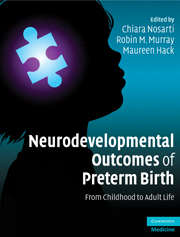Book contents
- Frontmatter
- Contents
- List of contributors
- Preface
- Section 1 Introduction
- Section 2 Neuroimaging
- Section 3 Behavioral outcome
- Section 4 Neuropsychological outcome
- Section 5 Applied research
- 16 Academic performance and learning disabilities
- 17 Pathways of risk and resiliency after prematurity: role of socioeconomic status
- 18 Cognitive and behavioral interventions
- Section 6 Conclusions
- Index
17 - Pathways of risk and resiliency after prematurity: role of socioeconomic status
from Section 5 - Applied research
Published online by Cambridge University Press: 06 July 2010
- Frontmatter
- Contents
- List of contributors
- Preface
- Section 1 Introduction
- Section 2 Neuroimaging
- Section 3 Behavioral outcome
- Section 4 Neuropsychological outcome
- Section 5 Applied research
- 16 Academic performance and learning disabilities
- 17 Pathways of risk and resiliency after prematurity: role of socioeconomic status
- 18 Cognitive and behavioral interventions
- Section 6 Conclusions
- Index
Summary
Introduction
Long-term survival for infants born very preterm (VPT < 32 weeks' gestation) increased dramatically with the regionalization of neonatal intensive care and resulted in decreased rates of major neurodevelopmental disabilities in survivors. For those born extremely preterm (EPT, < 28 weeks' gestation), survival has also increased dramatically, but there remains high rates of cognitive impairment and intellectual disability. However, despite these biomedical advances, environmental and social conditions that can deleteriously affect the health and well-being of these already vulnerable children have not improved in the USA. There are major gaps in accessing comprehensive family supports and quality early childhood experiences for recent cohorts of children at the highest biomedical and social risks. The purpose of this chapter is to examine the role of social and environmental factors in aggravating or moderating neonatal risks for suboptimal developmental and behavioral outcomes after VPT and EPT birth. We will also discuss available evidence from both longitudinal studies and community interventions for children at psychosocial disadvantage. This evidence offers important lessons to critically consider in evaluating developmental and educational trajectories for recent cohorts of children with the double jeopardy of VPT/EPT birth and social adversity.
Neonatal and social risks
The rate of preterm birth has risen in the past decade with approximately 1 in 7 infants in the USA born preterm each year[1]. Currently, 15 per 1000 US live births, more than 60 000 infants annually, are born with very low birth weight status (< 1500 g).
- Type
- Chapter
- Information
- Neurodevelopmental Outcomes of Preterm BirthFrom Childhood to Adult Life, pp. 224 - 236Publisher: Cambridge University PressPrint publication year: 2010
- 6
- Cited by



